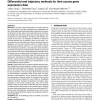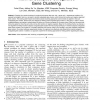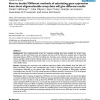66 search results - page 7 / 14 » Finding the Optimal Gene Order in Displaying Microarray Data |
BIOINFORMATICS
2005
13 years 7 months ago
2005
Motivation: The issue of high dimensionality in microarray data has been, and remains, a hot topic in statistical and computational analysis. Efficient gene filtering and differen...
TKDE
2008
13 years 7 months ago
2008
Clustering is a popular technique for analyzing microarray data sets, with n genes and m experimental conditions. As explored by biologists, there is a real need to identify coregu...
BMCBI
2006
13 years 7 months ago
2006
Background: Short oligonucleotide arrays for transcript profiling have been available for several years. Generally, raw data from these arrays are analysed with the aid of the Mic...
BIOINFORMATICS
2007
13 years 7 months ago
2007
Motivation: Clustering technique is used to find groups of genes that show similar expression patterns under multiple experimental conditions. Nonetheless, the results obtained by...
BMCBI
2006
13 years 7 months ago
2006
Background: A central goal of molecular biology is to understand the regulatory mechanisms of gene transcription and protein synthesis. Because of their solid basis in statistics,...



